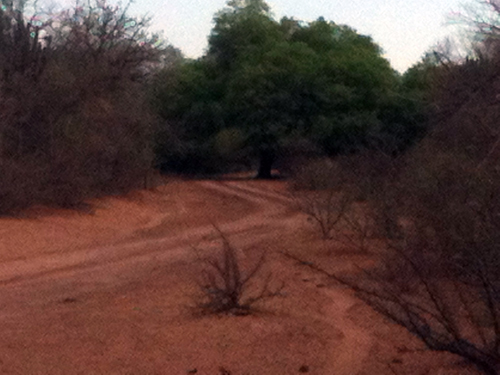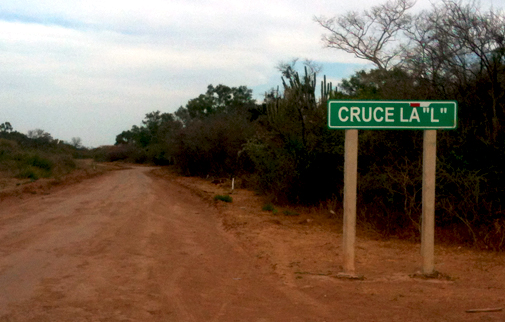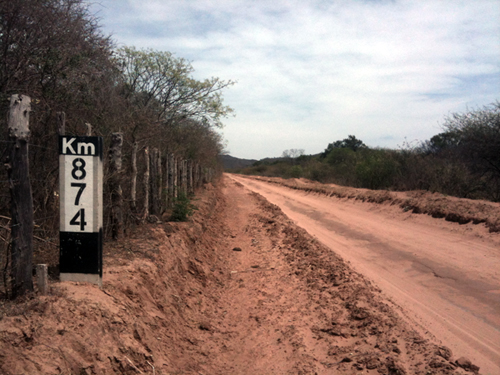Boyiube Chaco
by Bennett Hennessey
El Chaco es un desierto gris, habitado por espinas y serpientes, sin un pájaro cantor ni una huella de gente. - Eduardo Galeano - Memoria del Fuego 3 (1986)
 The Chaco habitat is a low, closed mix of short to medium trees and dense spiny shrubs that undergoes an extreme dry season (From May up to six months in the more southern Boyuibe area- ~1,100 mm per year). The long tough dry season has produced an extremely low diveristy of resident birds compared to other Bolivian lowland areas. Around four hundred species are known to occur in the Bolivian Chaco, but most of those are seasonal, and/or boreal or austral migrants. I doubt in the Boyuibe Chaco the resident bird community is not more than 70 species, where 45 can be seen in a day. This habitat distinction has made some species to be highly specialized to these conditions. The Chaco habitat is a low, closed mix of short to medium trees and dense spiny shrubs that undergoes an extreme dry season (From May up to six months in the more southern Boyuibe area- ~1,100 mm per year). The long tough dry season has produced an extremely low diveristy of resident birds compared to other Bolivian lowland areas. Around four hundred species are known to occur in the Bolivian Chaco, but most of those are seasonal, and/or boreal or austral migrants. I doubt in the Boyuibe Chaco the resident bird community is not more than 70 species, where 45 can be seen in a day. This habitat distinction has made some species to be highly specialized to these conditions.
The most accessible Chaco habitat appears to be the Boyuibe Chaco located ~6 hours drive from Santa Cruz. Walking along the Boyuibe Chaco road between road post signs 872 and 874 km there are four Bolivian Specialty birds: Chaco Chachalaca, Crested Hornero, Fawn-breasted Wren and Many-colored Chaco-finch. Other Chaco species present are Lark-like Brushrunner, Spot-winged Falconet, Short-billed Canastero, Chaco Earthcreeper, Little Thornbird, Black-legged Seriema, Little Nightjar and Cream-backed Woodpecker. Many of these birds are easy to see in a good birding day with vocalization knowledge. The Cream-backed Woodpecker drums continually and many of the song birds (passeriformes) can be found in mixed foraging on the ground with the dominate Red-crested Finches. This area could also have the Black-bodied Woodpecker and the Chaco Owl, though we could not detect them.
The Chaco is famous for its excessively hot temperatures, and this is to be heeded. All birding almost everywhere is best at the crack of dawn, but this cannot be stressed enough for the Chaco. You need to be birding as soon as light levels can identify colors (this can be 5 am in November), and stayed tuned in for the 3-4 hours of peak birding. After that, the heat overwhelms the scene and brings activity to an exhausted halt. We found things did not pick up again until around four pm.
We are still searching for the best spot to see the Bolivian Specialities- Black-bodied Woodpecker and Chaco Owl, but for the time being the Boyuibe Chaco area is very good for most of the Chaco species.
Logistics
 It would appear the km road markers to Camiri and Boyuibe begin in the city of Santa Cruz. From Santa Cruz travel south-west on the "doble via" road, which is also called the old road to Cochabamba. This road in Santa Cruz has three lanes on each side with a sidewalk in the centre- leaving the city south-west, eventually travelling west to such destinations as Samaipata, Comarapa, and Cochabamba. Take this road for around 15 km. After driving some ways out of the city, you will come to a two lane major paved road turning off left. This is highway 9 to the Chaco. Just after this turn off is the main toll stop for the road to Samaipata. It is the only principal road leaving left, and there should still be a road sign with an arrow pointing to Camiri. It would appear the km road markers to Camiri and Boyuibe begin in the city of Santa Cruz. From Santa Cruz travel south-west on the "doble via" road, which is also called the old road to Cochabamba. This road in Santa Cruz has three lanes on each side with a sidewalk in the centre- leaving the city south-west, eventually travelling west to such destinations as Samaipata, Comarapa, and Cochabamba. Take this road for around 15 km. After driving some ways out of the city, you will come to a two lane major paved road turning off left. This is highway 9 to the Chaco. Just after this turn off is the main toll stop for the road to Samaipata. It is the only principal road leaving left, and there should still be a road sign with an arrow pointing to Camiri.
Now you are on the beautifully paved Route 9 where you will be travelling pretty much straight south for the next few hours. On this road, I travelled 80 km an hour in my old Russian jeep, many cars keep to 100 km an hour, with plush shiny beasts filling the air with exhaust at 120 km. It is a truly decent road. So if we assume the road turn off route 9 starts at 25 km (I have no idea why), the driving distances you have ahead of you are, 138 km to Apapo which is the first town with an official gas station. Before that there are a few towns where a woman with a bucket can fill your tank for a price increase of 20% and a motor power decrease of 20% (purchased because the official Apapo gas station was out of gas). It is 212 km to Gutierrez, 291 km to Camiri and 315 km to the town of Boyuibe. From Santa Cruz to the good Boyuibe Chaco is 350 km. Camiri is a proper city, rather past its glory days of black gold riches, but still with proper gas stations, restaurants and decent hotels with pools (we like the hotel Las Tinajitas on the left as you arrive at Camiri). With bird groups, Bird Bolivia drives the afternoon to Camiri spending a nice night in an air conditioned hotel, to leave very early for the chaco.
 At the town of Boyuibe there appears to be very simple places to stay called alojamientos, but no pools, and if there is an air conditioner, you can be sure it will be a rattling old thing working equally hard to suck in air through years of filter accumulation than cooling the air. At Boyuibe you need to turn off your comfy paved road and land into the real bush experience bumpy dirt road. Upon arriving at Boyuibe, keep driving on Route 9, pass what would appear to be the town, to the point that you will think "surely this can't be right" when around a bend another group of run-down, mostly closed houses will appear. On your left will be a weather beaten sign Alojamiento 17 de Abril. In front of you, you will see a bit further on another road toll stop. You need to turn left here, off the paved road onto the dirt. You will immediately pass over some railroad tracks. Take the first right after the railroad tracks, and follow this dirt road one block, turning left at the next dirt road. You are now pointing east, and have begun your easterly travel to the lowland Chaco. You still need to leave Boyuibe, driving up 500 m you will pass a church on your left, and a run-down plaza. The road starts curving to the right. This is it, you are on Route 6 (high fives all around) (you can verify you are on the right road as you will see a large proper road sign backwards, with the reflective letters Boyuibe, for oncoming traffic). We have calculated that Route 6 starts out at km 838 with no logical explanation in close grasp. Route 6 is considered a main road in Bolivia, but at least to the extent that the road is well marked with km posts. The road really isn't too bad; at least there are not a lot of surprise pot holes. It is a dusty, dry road surfaced with often large rounded rocks and bumps. Nevertheless a bumpy ride which can get boring after an hour (a little trick that can help is reduce your tyre air pressure to 20 or 15 psi). At the town of Boyuibe there appears to be very simple places to stay called alojamientos, but no pools, and if there is an air conditioner, you can be sure it will be a rattling old thing working equally hard to suck in air through years of filter accumulation than cooling the air. At Boyuibe you need to turn off your comfy paved road and land into the real bush experience bumpy dirt road. Upon arriving at Boyuibe, keep driving on Route 9, pass what would appear to be the town, to the point that you will think "surely this can't be right" when around a bend another group of run-down, mostly closed houses will appear. On your left will be a weather beaten sign Alojamiento 17 de Abril. In front of you, you will see a bit further on another road toll stop. You need to turn left here, off the paved road onto the dirt. You will immediately pass over some railroad tracks. Take the first right after the railroad tracks, and follow this dirt road one block, turning left at the next dirt road. You are now pointing east, and have begun your easterly travel to the lowland Chaco. You still need to leave Boyuibe, driving up 500 m you will pass a church on your left, and a run-down plaza. The road starts curving to the right. This is it, you are on Route 6 (high fives all around) (you can verify you are on the right road as you will see a large proper road sign backwards, with the reflective letters Boyuibe, for oncoming traffic). We have calculated that Route 6 starts out at km 838 with no logical explanation in close grasp. Route 6 is considered a main road in Bolivia, but at least to the extent that the road is well marked with km posts. The road really isn't too bad; at least there are not a lot of surprise pot holes. It is a dusty, dry road surfaced with often large rounded rocks and bumps. Nevertheless a bumpy ride which can get boring after an hour (a little trick that can help is reduce your tyre air pressure to 20 or 15 psi).
Now all this travelling you have been doing has been in interesting relatively nature habitat, and I know you will be tempted to stop and bird, but I recommend that you be a bit more patient. You are a large transition zone between Andean Dry Valley habitat and birds, and the Chaco birds- but this does not hold the best of either worlds. You will be in much better Andean dry valleys in the Red-fronted Macaw Reserve, and the really good Chaco, all the birds you are after, is further down. You need to travel on the Boyuibe Chaco road 34 km before you will reach the beginning of the lowland flat (and hot) Chaco habitat. The road will continue to descend, rise, climb to eventually take you over the last Andean ripple descending into flat Chaco at road post 872 km. Now be warned, you are in the middle of nowhere. No towns, no houses, just large open ranch land with the occasional off the road ranch house. We clocked a passing car around once an hour, with no traffic during the heat of the day, or at night. So go prepared. At around km post 876 km there is a sign "Cruce la "L"" with a road turning off at the right (south). Around 400 m further on this road is a large green tree that could offer very important shade for a hot midday wait for things to pick up again. I have not ventured further on this road, but if your vehicle is up to it, this could offer some good jeep roadside birding. Looking at images in Google Earth, it looks pretty much the same the next 90 km to Paraguay. We did not see such important Chaco birds as the Black-bodied Woodpecker or the Chaco Owl, which I suspect might be more common, or present, further on the road.
See the Boyiube Chaco bird list of a two day visit by Bird Bolivia in June.
Below is a list of birds which you only find in the Chaco of Bolivia (some have a large range in Paraguay and even Argentina). (see Bolivian Specialities).
Chaco Chachalaca Ortalis canicollis
Spot-winged Falconet Spiziapteryx circumcinctus
Yellow-breasted Crake Porzana flaviventer
Spot-flanked Gallinule Gallinula melanops
Black-legged Seriema Chunga burmeisteri
Scaled Ground-Dove Columbina squammata
Pearly-breasted Cuckoo Coccyzus euleri
Chaco Owl Strix chacoensis
Black-bodied Woodpecker Dryocopus schulzi
Crested Hornero Furnarius cristatus
Short-billed Canastero Asthenes baeri
Little Thornbird Phacellodomus sibilatrix
Lark-like Brushrunner Coryphistera alaudina
Crested Gallito Rhinocrypta lanceolata
Black-crowned Monjita Xolmis coronata
Many-colored Chaco-Finch Saltatricula multicolor |

